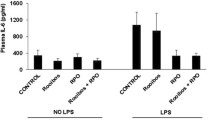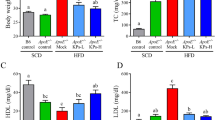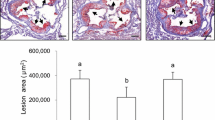Abstract
The objective of this study was to develop a rice porridge containing perilla oil rich in α-linolenic acid which demonstrated anti-atherogenic effect in the previous study. Lipid lowering effect of emulsified perilla oil (EPO) was examined in apo E KO mice (n=18) and that for rice porridge containing EPO (RPEPO) was investigated in the pilot scale human study (n=20). Inhibitory effects of EPO on the plasma lipid levels and fatty streak lesion size in apo E KO mice were similar to those observed in mice fed perilla oil (PO), suggesting that EPO is applicable form of PO in manufacturing rice porridge product with PO’s health benefit properties. In human study with young adults aged between 20–35 years old, changes in plasma triglyceride concentration of subjects consumed RPEPO for 30 days as a breakfast was significantly lowered than those for subjects consumed rice porridge (p<0.05), of which calorie levels were the same (333 kcal/meal).
Similar content being viewed by others
References
Shin HS, Kim SW. Lipid composition of perilla seed. J. Am. Oil Chem. Soc. 71: 619–622 (1994)
Ihara M, Umekawa H, Takahashi T, Furuichi Y. Comparative effects of short- and long-term feeding of safflower oil and perilla oil on lipid metabolism in rats. Comp. Biochem. Phys. B. 121: 223–231 (1998)
Kim HK, Choi S, Choi H. Suppression of hepatic fatty acid synthase by feeding alpha-linolenic acid rich perilla oil lowers plasma triacylglycerol level in rats. J. Nutr. Biochem. 15: 485–492 (2004)
Sadi AM, Toda T, Oku H, Hokama S. Dietary effects of corn oil, oleic acid, perilla oil, and evening primrose oil on plasma and hepatic lipid level and atherosclerosis in Japanese quail. Exp. Anim. Tokyo 45: 55–62 (1996)
Onogi N, Okuno M, Komaki C, Moriwaki H, Kawamori T, Tanaka T, Mori H, Muto Y. Suppressing effect of perilla oil on azoxymethaneinduced foci of colonic aberrant crypts in rats. Carcinogenesis 17: 1291–1296 (1996)
Shoda R, Matsueda K, Yamato S, Umeda N. Therapeutic efficacy of n-3 polyunsaturated fatty acid in experimental Crohn’s disease. J. Gastroenterol. 8: 98–101 (1995)
Yamamoto N, Saitoh M, Moriuchi A, Nomura M, Okuyama H. Effect of dietary alpha-linolenate/linoleate balance on brain lipid compositions and learning ability of rats. J. Lipid Res. 28: 144–151 (1987)
Hong SH. Anti-atherogenic effects of perilla oil as dietary lipid source of n-3 fatty acid in apoE knockout mice. MS thesis, University of Pusan, Busan, Korea (2011)
Lee J, Song YO. Perilla oil rich in α-linolenic acid suppresses hepatic SREBPs and NF-κB expression in hypercholesterolemiainduced apolipoprotein E knockout mice. Food Sci. Biotechnol. 21: 807–813 (2012)
Seong J, Song YO. Perilla oil rich in α-linolenic acid inhibits neuronal apoptosis and the expression of inflammation-mediator protein in apoE KO mice. Biocatal. Agric. Biotechnol. 1: 167–173 (2012)
Moon JH, Lee JT. Effects of convenience foods on overall satisfaction; focus on the Deluxe hotels. J. Hospital. Tour. Stud. 25: 206–219 (2007)
Mun YS, Jung EK, Joo NM, Yoon JY. A study on the intakes and perceptions of convenient breakfast. Korean J. Commun. Nutr. 16: 559–568 (2011)
KHIDI. Food Industry Analysis Report 2011. Korea Health Industry Development Institute, Chungcheonbuk-do, Korea. p. 18 (2011)
Shin ES, Lee KA, Lee HK, Kim KBWR, Kim MJ, Byun MW, Lee JW, Kim JH, Ahn DH, Lyu ES. Effect of grain size and added water on quality characteristics of abalone porridge. J. Korean Soc. Food Sci. Nutr. 37: 245–250 (2008)
Kim AJ, Kim MW, Woo NR. Processing of convenient rice gruels with sericultures. J. Korean Soc. Food Sci. Nutr. 20: 179–184 (2007)
Park BH, Cho HS. Quality characteristics of jook prepared with lotus root powder. Korean J. Economics Assoc. 47: 79–85 (2009)
Lee MK, Choi SH, Lim HS, Ahn JS. Quality characteristics of jook prepared with green laver powder. Korean J. Food Cookery Sci. 26: 552–558 (2010)
Kim HK, Choi S, Choi H. Suppression of hepatic fatty acid synthase by feeding α-linolenic acid rich perilla oil lowers plasma triacylglycerol level in rats. J. Nutr. Biochem. 15: 485–492 (2004)
Longvah T, Deostahle YG, Kumar PU. Nutritional and short term toxicological evaluation of perilla seed oil. Food Chem. 70: 13–16 (2000)
Chang HH, Chen CS, Lin JY. Dietary perilla oil lowers serum lipids and ovalbumin-specific IgG1, but increases total IgE levels in ovalbumin-challenged mice. Food Chem. Toxicol. 47: 848–854 (2009)
Ide T, Kobayashi H, Ashakumary L, Rouyer IA, Takahashi Y, Aoyama T, Hashimoto T, Mizugaki M. Comparative effects of perilla oil and fich oils on the activity and gene expression of fatty acid oxidation enzymes in rat liver. Biochim. Biophys. Acta 1485: 23–35 (2000)
Hansson GK, Libby P. The immune response in atherosclerosis: A double-edged sword. Nat. Rev. Immunol. 6: 508–519 (2006)
Shoda R, Matsueda K, Yamato S, Akiyama J, Muraoka A, Masaki N, Hayashi S, Shimojo E, Mahalanabis D. Therapeutic efficacy of polyunsaturated fatty acid on diarrhea and hypoglycemia in the rat fed with red kidney bean lectin. Digestion 22: 75–78 (1999)
Atakisi E, Atakisi O, Yaman H, Arslan I. Omega-3 fatty acid application reduces yolk and plasma cholesterol levels in Japanese quails. Food Chem. Toxicol. 47: 2590–2593 (2009)
Park EJ, Cheong HS, Shin DS. A study on health condition and nutritional status of female university students in Masan area. J. Korean Soc. Food Sci. Nutr. 33: 1501–1514 (2004)
KNS. Dietary Reference Intakes for Koreans 2010. 1st rev. The Korean Nutrition Society, Seoul, Korea (2010)
Yoon SJ, Hawer WD. A study on calorie and proximate components of traditional Korea gruel. J. Korean Soc. Food Sci. Nutr. 37: 879–885 (2008)
Author information
Authors and Affiliations
Corresponding author
Rights and permissions
About this article
Cite this article
Jo, H., Kim, M., Lee, J. et al. Anti-atherogenic properties of emulsified perilla oil (EPO) in apo E KO mice and plasma lipid lowering effects of rice porridge containing EPO in healthy young adults. Food Sci Biotechnol 22, 79–85 (2013). https://doi.org/10.1007/s10068-013-0011-2
Received:
Revised:
Accepted:
Published:
Issue Date:
DOI: https://doi.org/10.1007/s10068-013-0011-2




